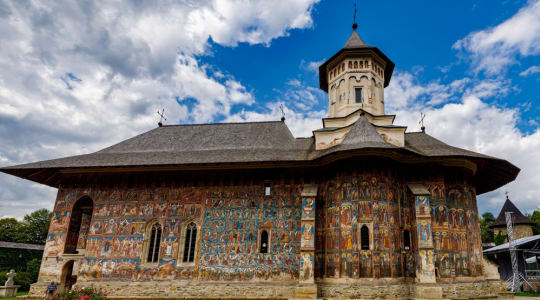
Moldovita Monastery is a Romanian Orthodox monastery located in the northern part of Romania, in the region of Bucovina. It was built in the 16th century, between the years of 1532 and 1537, by Petru Rares, a Moldavian prince. The monastery is part of the UNESCO World Heritage Sites, which include several other painted monasteries of Bucovina.
The exterior walls of the monastery are decorated with frescoes depicting religious scenes and saints, which are considered to be some of the most well-preserved and finest examples of Byzantine art in Europe. The colors used in the frescoes are still very vibrant, even after centuries of exposure to the elements. The frescoes are also notable for their unique depictions of scenes from the Bible, including the story of Adam and Eve and the Last Judgment.
The interior of the monastery is equally impressive, with a central nave and a series of side chapels, each adorned with colorful frescoes. The walls and ceilings are painted in bright colors and the iconostasis, a screen separating the nave from the sanctuary, is intricately carved and decorated with gold leaf. The monastery also houses a museum, which displays a collection of religious artifacts and icons, some of which date back to the 15th century.
Moldovita Monastery continues to serve as a functioning Orthodox monastery to this day, with daily liturgies and religious services. It is considered to be one of the most important cultural and historical landmarks in Romania, attracting tourists from all over the world.
Explore Near Moldovita monastery
Discover 2 attractions, 1 city, and 2 airports within 75km. Perfect for planning day trips, finding connecting flights, or discovering new destinations to explore during your visit.
Nearby Attractions & Places to Visit
2 destinations within 17.1km - 64.9km from your location


Nearby Cities Worth Exploring
1 destination within 50.9km from your location
Airports Near Moldovita monastery
2 destinations within 58.7km - 73.6km from your location
Cross-Border Adventures Near Moldovita monastery
Discover cross-border adventures near Moldovita monastery. Explore neighboring countries with similar attractions and extend your travel experience across borders.




